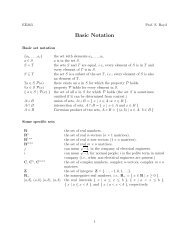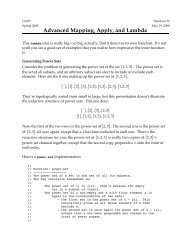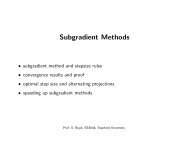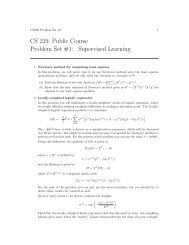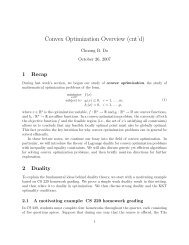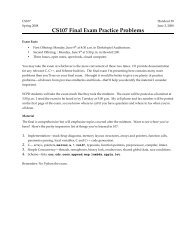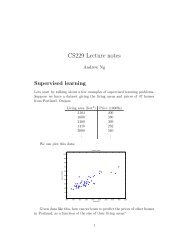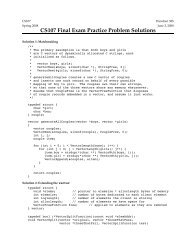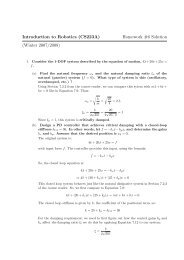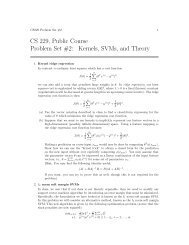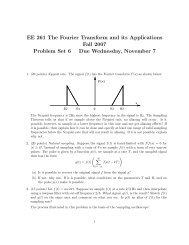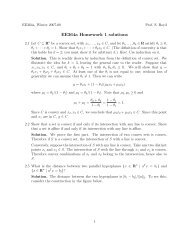Assignment #5 â Yahtzee! - Stanford Engineering Everywhere
Assignment #5 â Yahtzee! - Stanford Engineering Everywhere
Assignment #5 â Yahtzee! - Stanford Engineering Everywhere
Create successful ePaper yourself
Turn your PDF publications into a flip-book with our unique Google optimized e-Paper software.
– 5 –two dice for his final roll, but is again unsuccessful in his quest for more 5’s. Eric endsup with the three 5’s, a 6, and a 3, as shown in Figure 4.Figure 4 (After Eric’s final roll of his first turn, choosing category Three of a Kind)While Eric didn’t manage to secure a <strong>Yahtzee</strong>, he did come up with a reasonably decentThree of a Kind. When asked to choose a category, Eric clicks Three of a Kind, and ascore of 24 points will be recorded in the column.Now it’s Julie’s turn. Julie has better karma than Eric, but we won't talk about that rightnow. Anyway, Figure 5 shows the configuration of the dice at the end of her three rolls:three 2’s and two 3’s. Julie is quite pleased and plans to use this configuration for a FullHouse, which is worth 25 points and gives her the early lead.Figure 5 (After Julie’s final roll of her first turn, as she is choosing her category)
– 8 –Figure 9 (At the end of the game)What is provided in the starter projectThe starter project provides the following:• A <strong>Yahtzee</strong>.java file that you need to expand to play the game. The initializationcode, however, is already provided.• A <strong>Yahtzee</strong>Constants.java file that defines several constants used in the game. Thecontents of this file appear in Figure 10 on the next page. Some of these are simpleconveniences, such as defining the number of dice to be the named constant N_DICE.The most important entries, for you to understand are the category constants at the endof the file. These constants form an enumeration that allows you to refer to constantson the score sheet. These constants are available to the <strong>Yahtzee</strong> class because itdeclares itself as implementing the <strong>Yahtzee</strong>Constants interface.• A precompiled class called <strong>Yahtzee</strong>Display that manages all the graphics and eventhandling. You’ve already shown your mettle with the graphics library on <strong>Assignment</strong>s3 and 4, so this time we’ll take the graphics off your plate. This class is discussed inmore detail in the section that follows.• A precompiled class called <strong>Yahtzee</strong>MagicStub that exports a method checkCategorythat will allow you to get your program working a little sooner. You have to write thismethod on your own before you submit your assignment, but having a workingimplementation available means that you can test your scoring methods without havingto work out the details of this method as well.
– 9 –Figure 10. The <strong>Yahtzee</strong>Constants interface/** File: <strong>Yahtzee</strong>Constants.java* ---------------------------* This file declares several constants that are shared by the* different modules in the <strong>Yahtzee</strong> game.*/public interface <strong>Yahtzee</strong>Constants {/** The width of the application window */public static final int APPLICATION_WIDTH = 600;/** The height of the application window */public static final int APPLICATION_HEIGHT = 350;/** The number of dice in the game */public static final int N_DICE = 5;/** The maximum number of players */public static final int MAX_PLAYERS = 4;/** The total number of categories */public static final int N_CATEGORIES = 17;/** The number of categories in which the player can score */public static final int N_SCORING_CATEGORIES = 13;/* The constants that specify categories on the scoresheet */public static final int ONES = 1;public static final int TWOS = 2;public static final int THREES = 3;public static final int FOURS = 4;public static final int FIVES = 5;public static final int SIXES = 6;public static final int UPPER_SCORE = 7;public static final int UPPER_BONUS = 8;public static final int THREE_OF_A_KIND = 9;public static final int FOUR_OF_A_KIND = 10;public static final int FULL_HOUSE = 11;public static final int SMALL_STRAIGHT = 12;public static final int LARGE_STRAIGHT = 13;public static final int YAHTZEE = 14;public static final int CHANCE = 15;public static final int LOWER_SCORE = 16;public static final int TOTAL = 17;}
– 10 –The <strong>Yahtzee</strong>Display classAs noted in the preceding section, the starter project contains a precompiled class called<strong>Yahtzee</strong>Display that manages the drawing and event-handling. This section of thehandout offers a brief overview of the methods, which should be enough to get youstarted. The assignments area of the CS 106A web site contains a javadoc file for<strong>Yahtzee</strong>Display that displays the full story, the important parts of which are reproducedas Figure 11 on the next two pages.• There is a constructor method <strong>Yahtzee</strong>Display that creates the initial display. It takesas parameters the GCanvas for the <strong>Yahtzee</strong> program and an array containing the namesof each player. The call to this method is included in the <strong>Yahtzee</strong>.java starter filewe’ve provided to you.• The waitForPlayerToClickRoll method is used at the beginning of each player’sturn. It waits for the player to click the Roll Dice button indicating they are ready to taketheir chances.• The displayDice method draws the dice on the board. It takes an array of N_DICEvalues. You call this method to draw the random dice results you generated on eachroll or reroll.• The waitForPlayerToSelectDice method allows the player to click on the dice toselect and deselect which ones should be rerolled. You call this method on the secondand third rolls of the player’s turn to find out which dice they wish to reroll.• The isDieSelected method allows you to check whether the player has chosen toreroll a particular die. You call this method after waitForPlayerToSelectDicereturns to determine which dice you need to reroll and which you can leave alone.• The waitForPlayerToSelectCategory method allows the player to click on thescorecard to select a category. You call this method at the end of the player’s turnwhen they need to choose the category to assign the current dice configuration. Themethod returns the number of a category, as defined in <strong>Yahtzee</strong>Constants.• The updateScorecard method updates a score entry on the scorecard. You call thismethod at the end of the player’s turn to report the latest score. It takes a playernumber, a category, and a value, and updates the scorecard to display that value in theproper row and column.• The printMessage method allows you to display a message at the bottom of thegraphics window. This method works exactly like println and allows you to includevalues in exactly the same way. For example, if you want to display the messageEric's turn.with the name Eric replaced by the contents of the string variable name, you could usethe following call to printMessage:display.printMessage(name + "'s turn.");As this last example illustrates, any calls to the methods in the <strong>Yahtzee</strong>Display classmust include the variable display as the receiver. You are asking the display to printa message and therefore must use the receiver-based style of method call.
– 11 –Figure 11. Entries in the <strong>Yahtzee</strong>Display classpublic <strong>Yahtzee</strong>Display(GCanvas gc, String[] playerNames)Creates a new <strong>Yahtzee</strong>Display object that adds its objects to the GCanvas specified by gc. TheplayerNames parameter is an array consisting of the names of the players.Usage: <strong>Yahtzee</strong>Display display = new <strong>Yahtzee</strong>Display(gc, playerNames);Parameters: gc The GCanvas on which the board is displayedplayerNames An array containing the names of the players, indexed from 0.public void waitForPlayerToClickRoll(int player)Waits for the player to click the "Roll Dice" button to start the first dice roll. You will call this methodonce at the beginning of each player's turn. The parameter is the index number of the player, whichranges from 1 to nPlayers, where nPlayers is the number of players in the game. The methodhighlights the player's name in the scorecard, erases any dice displayed from previous rolls, draws the"Roll Dice" button, and then waits for the player to click the button. This method returns when thebutton is pressed. At that point, it is your job to randomly roll the dice and call the displayDicemethod.Usage: display.waitForPlayerToClickRoll(player);Parameter: player The index of the player, ranging from 1 to nPlayerspublic void displayDice(int[] dice)Draws the pictures of the dice on the screen. You pass one parameter, a zero-based integer array withN_DICE entries, that contains the values to draw on the dice. Each value in the array must be a validdie roll between 1 and 6; if not, displayDice will throw an ErrorException. You will need to callthis method after each roll or reroll of the dice to display the new random values.Usage: display.displayDice(dice);Parameter: dice An array of dice values, whose indices range from 0 to N_DICE - 1public void waitForPlayerToSelectDice()Allows the player to select which dice to reroll by clicking on the dice with the mouse. You will callthis method twice each player turn, giving them two additional chances to improve their roll. Thismethod draws the "Roll Again" button, and waits for the player to click on the dice to select anddeselect which ones they would like to reroll. The method returns only after the player has made aselection and clicks the "Roll Again" button. Once the method returns, you can use theisDieSelected method to determine whether the die should be rerolled.Usage:display.waitForPlayerToSelectDice();public boolean isDieSelected(int index)Checks to see whether the die specified by index is selected. You call this method before each reroll todetermine whether this die needs to be updated.Usage: if (display.isDieSelected(index)) . . .Parameter: index The index number of the die, which ranges from 0 to N_DICE - 1Returns: true if the die is selected, and false otherwisepublic int waitForPlayerToSelectCategory()Allows the user to select a category in which to place the score for this roll. You will call this methodonce each turn after the player finishes rolling the dice. As its name suggests, the method waits for theplayer to click on one of the categories and returns the index of the category, which will be one of theconstants defined in <strong>Yahtzee</strong>Constants. Note that this method does not check to see whether thecategory is valid for the dice values or whether this category has already been used by this player.Thus, you will need to include some error-checking in your program to test the result ofwaitForPlayerToSelectCategory before you try to update the scorecard.Usage:Returns:int category = display.waitForPlayerToSelectCategory();The category number selected by the player
– 13 –stored in the array are valid for the category and false otherwise. Note some categories(namely, Chance and Ones, Twos, etc.) accept any dice configuration; for these categoriescheckCategory always returns true. The javadoc describing the class<strong>Yahtzee</strong>MagicStub is available from the "<strong>Assignment</strong>s" page of the CS106A web site,but for your convenience, we note that the static method<strong>Yahtzee</strong>MagicStub.checkCategory can be called as follows (assuming we have anarray of ints named dice that we want to check to see if it matches the Full Housecategory):boolean p = <strong>Yahtzee</strong>MagicStub.checkCategory(dice, FULL_HOUSE);In the early stages of your development, you can use our checkCategory method to helpyou get up and running. Ultimately, however, you need to write this method yourself. Asyou develop your own version of this method, you’ll probably want to test it in stages.You could, for example, write a method that tests the validity of, say, Three of a Kind, butuses the implementation from <strong>Yahtzee</strong>MagicStub for everything else. When that works,you could move on to take care of Four of a Kind, and then <strong>Yahtzee</strong> and Full House.Once you have your own methods for checking the validity of these categories, move onto tackling Small Straight and Large Straight.For full credit, you should not use <strong>Yahtzee</strong>MagicStub.checkCategory anywhere in thefinal version of your program. If you find determining the validity of a certain categoryor categories too difficult, you may use our method, but you will lose points for eachcategory whose validity you do not check with your own implementation.In a similar vein, look for other intermediate milestones you can aim for instead ofheading straight for the final goal and letting it overwhelm you. For example, it is easierto get a single-player game working than a multi-player game. If there is only one player,you can work with a single array of scores. After you can reliably play a single-persongame, you can move on to support an array of players’ scores where a multidimensionalarray will be needed.You also might find it worthwhile to create a ―cheat‖ mode during development. If youare running in cheat mode, you can prompt the user to specify the values by typing themin instead of choosing the dice randomly. Implementing this feature will make it easierfor you to check the various situations that can come up during the game, rather thanwaiting and hoping for them to come up randomly at some point during your testing.Hints and other random details• There’s not a great deal difference between determining the validity for Three of aKind, Four of a Kind, <strong>Yahtzee</strong>, and Full House.• There’s not a great deal of difference between determining the validity for SmallStraight and Large Straight.• Any dice configuration is valid for Ones, Twos, Threes, Fours, Fives, Sixes, andChance.• A dice configuration assigned to a category where it doesn’t meet the requirementsreceives a score of 0.
– 14 –• You should print text messages along the way to inform the players what to do next(whose turn it is, when the player should roll, when to select dice for rerolling, when tochoose a category, who the winner is, etc.). You can use the demo applet provided onthe CS106A as a guide to the sorts of messages you should give the players.• Be sure to check for errors when the player selects the category to assign a diceconfiguration. The user cannot re-use any previous category. Print a message if youcannot honor their choice and have them select another.• On each turn, a player will roll the dice three times. If a player doesn’t want to changeanything on a subsequent roll, that player should click the Roll again button withoutselecting any dice.• At the end of the game, don’t forget to compute and assign the upper bonus (35 pointsif their upper score is 63 or over), upper score, lower score, and final total.• Be sure to mark all methods as private unless you explicitly plan for them to be usedoutside the module. The grading criteria that we will use for the assignment willinclude a deduction along these lines.ExtensionsSince the standard assignment is pretty much a full implementation of the <strong>Yahtzee</strong> game,it is hard to come up with ideas for extensions, but don’t let our lack of creativity stop youfrom exploring things that you would find interesting. Here’s at least a few ideas thatoccurred to us:• Add a high score feature. Save the top ten highest scores and names to a file and makeit persistent between runs of the program. Read the file when you start and print out thehall of fame. If a player gets a score that preempts one of the early high scores,congratulate them and update the file before you quit so it is recorded for next time.• Incorporate the bonus scores for multiple <strong>Yahtzee</strong>s in a game. As long as you have notentered a 0 in the <strong>Yahtzee</strong> box, the rules of the game give you a bonus chip worth 100points for each additional <strong>Yahtzee</strong> you roll during the same game.• Beef up your <strong>Yahtzee</strong> to the variant called “Triple <strong>Yahtzee</strong>.” In this variant, eachplayer manages three simultaneous scorecard columns, as if they were playing for threeplayers at once. The player can assign a roll to any one of their three columns. Allentries are scored normally with respect to categories and validity, but the values in thesecond column are doubled, and the third column values are tripled. The player’sscore consists of the sum of all three columns. This would make for a threedimensionalarray (an array of players who have any array of columns which are anarray of score entries)—pretty tricky! Game play continues for 3*13 rounds, until allplayers have filled in all entries in all three columns. The player with the highest totalscore is the winner.As always, you should only tackle extensions after you have completed and thoroughlytested all the basic requirements. If you do create an extended version, please hand inboth a basic and an extended version to make it easier for us to verify the basefunctionality. Small extensions that don’t disrupt the basic functionality are fine toinclude in one version. Be sure to describe in your comments where we should look foryour fun additions!



